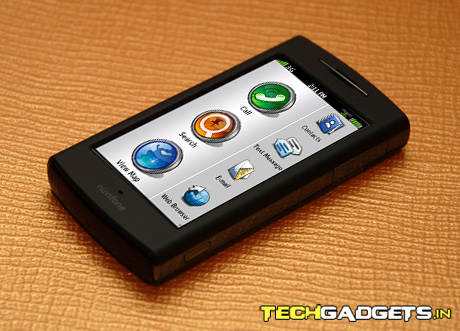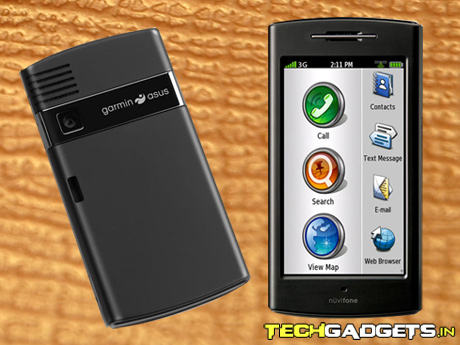
Two years. Pretty long time for a phone enthusiast biding his time to net a mobile device. Well, those sharp on wits will remember the nuvifone G60 that was talked about in 2008. Thankfully, the good folks over at Garmin and Asus were able to get the G60 out to AT&T before the Christmas 2009.
But is it too late? Beyond any shadow of doubt, a lot has happened in the mobile world between then and now. The iPhone 3G has fallen to $99, a ton of Android devices have hit the world and dedicated portable navigation devices have found themselves in the bargain bin. Not to forget, some pretty GPS software has also managed to set foot in Apple’s App Store and the Android Market. To put it plain, has nuvifone G60 managed to stand apart in such a tough competition prevailing outside the window? To answer that, here’s a comprehensive review of the Garmin-Asus nuvifone G60.
The smartphone came to us packed in a neat black box, lying pretty sturdily in an impressive black body. To help us get started, Garmin-Asus dropped a neat leather case bearing the Garmin-Asus logo, a travel adapter for charging, a quick start manual, headphones and a car navigation kit. On switching on the touchscreen phone, it gave us a straight out of the image look, no more different and no less same.
The size and screen of the phone appeared pretty cool to us, though not so-convenient to carry in that wee-sized pocket! In terms of amplitude, it seems to typically fit the bill with being not too big for a phone and not too small for a navigation device. But at the same time, our fingers felt it to be beefy, leaving us with a feeling to flaunt something sleeker. Overlooking that aspect, if you are among those spending most of your time on business trips, you will certainly groove on the exquisite and neat chassis of the phone. The case of G60 is black with a matte finish in the front and back.
The left and right edges holding the front and the back panel are built with steel while the top and bottom part of the chassis give a chatoyant look. There’s a microSD card slot lodged on the left edge followed by a USB port. A dedicated 3 megapixel camera for photography fiends stretches arms on the bottom of the right edge and above it eases up a button that helps increase or decrease the volume. The front speaker is featured in a slit just above screen while the word ‘nuvifone’ is engraved neatly below the screen. Turning the phone showed the Garmin-Asus logo neatly tailored onto a thick strip of steel which also includes the camera lens next to the logo. There’s a square shaped speaker just above the camera lens while the top portion houses the 2.5mm headset jack. Just beside it, is the power on/off and lock/unlock button. Other than this, the front face of the phone is bare with no buttons.
The main screen of the device features three noticeable functions, Call, Search and View Map. With a neatly divided scrollball menu, we were able to easily scroll through the other contents of the phone. We could customize the Menu by simply going to the Application Settings. Apart from this, we could also adjust the brightness up to 100 percent through the Display Settings. There’s also a Color Mode that chooses from Auto, Daytime and Nighttime options, proffering the best resolution. But unfortunately, a shortcut to the home menu was found ‘out to lunch’ from the device. We found the screen quite responsive to the finger touch, swiping through the phone for navigation was also a good experience. Designed to be dual-purpose, the surface of the device makes it suited for the car dashboard, accredit to its non-slip aspect.

Talking about its software that will make or break this gizmo, the user interface appeared quite decent. The dialer screen, contact list and recent calls tab are all fairly basic while the threaded text message screen helped us keep track of our conversations. We didn’t find any qualms with setting up our Gmail account and downloading our most recent messages onto the phone. But the absence of more advanced features like stars and labels did throw a pall over us to some extent. The extras that Garmin-Asus throws in includes features like weather, flight status, converter, local events and more.
Another thing that came into view as a little oddball was the emplacement of a QWERTY keypad. While it is displayed in the landscape mode, the phone shows off a standard keypad in the portrait mode. Though the messaging feature had predictive text, the keys were too small to type properly and most of the time we simply ended up typing the wrong keys, avid message users may be disappointed here. For those with euphonious ears, the handset sports a decent music player and an Audio Boost feature. Again disappointingly, though it lends support to Bluetooth, there’s no send via Bluetooth option in messages, images or music files. The navigation system bobs up as the most highlighted feature.
The nuvifone G60 comes preloaded with local maps including North America, Eastern and Western Europe, or specific Asia-Pacific regions. The navigation software is dedicated to G60 which is almost like Garmin’s Mobile XT. Interestingly, the system implementing the turn-by-turn voice-prompted directions allowed us to find out their latitude and longitude coordinates. If you are confused about where to head, take help from a local search feature that connects to a server to find points of interest. The rear speaker ensured navigation instructions were loud and clear. Home, Points of Interest, Favorites, Recently Found and Cities are some other features that essay navigation. But it misses the ‘Go to’ option, leaving everybody wondering why a navigation-centric device would leave that out. As a combination of a navigation gizmo and phone, the G60 allowed us to toggle between calls and routing without deep waters.
Further, the handset is equipped with an advanced mobile HTML web browser. You can easily surf the web on your mobile device via Wi-Fi or 3G networks. The device was also seen supporting POP3 and IMAP4 email such as Yahoo!, Hotmail and Gmail. On voice clarity, it ensures a decent call reception. Its Linux-based operating system nature shines through when using the three megapixel camera with auto-focus. Well, with the camera, we clicked a few pictures and didn’t ruin the prospects of capturing good-quality images.
Although mobile phones have always been considered an important device for safety, the nuvifone G60 takes it one step further by allowing individuals to place calls and identify their exact GPS location while making a phone call. Overall, the Garmin-Asus nuvifone G60 makes the scene as an ideal choice for users who are looking for a navigation device with the ability to engage in conversations. With navigation at its heart and a chunk of complicated functions, it still drops in as an appreciable routing gizmo. As a navigation mobile phone, we’d give the G60 a fair 8 out of 10. The Garmin-Asus nuvifone G60 comes with a price tag of Rs. 30,000.




